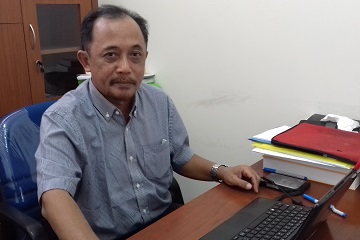A Group of IPB Researchers Assessing the Suitability and Availability of Land for Agriculture In Indonesia, with Special Reference to Pantura

Indonesia has long sought to restore its self-sufficiency in key agricultural commodities, such as rice, while also increasing domestic production of high-value food products, such as beef. However, Indonesia currently still has problems in the provision of food. Rice is the main staple food of the Indonesian people and it contributes as an essential element of rural development in Indonesia. Statistics show that Indonesia is still among countries that are importing huge amounts of food staples, and the imports increase every year. Rice supply has become a major problem in Indonesia particularly in the last two decades when self-sufficiency is unable to be maintained. To meet the needs of approximately 250 million people, Indonesia needs at least 28 million tons of rice per year to be provided, the highest among the world's. Indonesian food production depends highly on Java Island, which holds the most fertile soils in the country but had limited area. However, the increasing population growth, rice fields in Java are currently under pressure from other land uses such as industry and housing. To that end, the government has produced Law No. 41 of 2009 on sustainable food agriculture, among others, to protect rice fields on the island of Java.
In order to respond such situation a group of researchers of IPB consisting of Widiatmaka and Supiandi Sabiham of the Department of Soil Science and Land Resources, of the Faculty of Agriculture of Bogor Agricultural University (FAPERTA IPB); Machfud from the Department of Agricultural Industrial Technology, of the Faculty of Agricultural Technology (FATETA IPB); Paulus B.K. Santoso of the Secretariat General of the Ministry of Agriculture; Muhamad Hikmat of R & D Agency, Ministry of Agriculture; and Wiwin Ambarwulan of the Geospatial Information Agency implemented the research program on Pantura, Java, to support national food security.
"So the problem is, we need a lot of food but rice food, and that is mostly still produced from Java Island," said Widiatmaka.
He said, approximately 47 percent of the area of rice fields in Indonesia, currently located on the island of Java. The data from the last census indicated that the population of Indonesia was 237 million in 2010 and has been estimated to become 255 million in 2015, an increase of 7.6% during last 5 years. This number makes Indonesia become the fourth largest country in the world by population. Rice is the staple food for 95% of the Indonesian population; however, most rice was produced from paddy fields in Java Island. Of the total 13.8 million ha of paddy fields in Indonesia, 6.5 million ha or 46.7% was in Java Island. The paddy fields in Java Island produced 52.6% of Indonesia’s total rice production, suggesting the very high Indonesia’s dependence on Javanese agriculture. With the island’s area making up less than 7% of the total area of Indonesia, the very high dependence on Javanese agriculture is very risky for future national food security. In this most populous island, there is high pressure on agricultural land due to the need for infrastructure such as housing, roads, and industry.
The objectives of this study were to formulate a model of sustainable agricultural land-appropriation, with a case study in Subang District, in the context of maintaining one of the northern coastal areas of Java as a food provider, so as to contribute sufficiently to national food sovereignty.
"My research would investigate, if we decide whether a conservation area is created, which areas are desirable to preserve. Should all be protected, but in protecting we also have limitations, both funds and the needs of other sectors of land, so it must be selected which priority is protected. In some areas we have delineated, there are criteria for priority, such as fertility, proximity to irrigation channels, proximity to markets and so on. If you want to protect areas, how about farmers of those areas, provide incentive for them, if the incentives are a subsidy, do we have funds for them. The output of the study may provide the information for developing policy that needs to be set in relation to Indonesia’s high dependence on Javanese agricultural production, "he explained.
In the scenario of protection of the established wetland land, the team revealed that to meet the needs of the area consumption in 2031 in Subang for example, then the minimum rice field that must be protected is 22,183 hectares. If desired, Subang area can still export 50 percent of production.
The team suggested a minimum of 54,969 hectares of protected paddy fields are required. Efforts to increase production are arranged in various scenarios for increasing the crop index and productivity. Qualitative operational research methods of problem structuring have been used to address quality improvement in services involving multiple sectors but not in combination with quantitative operational research methods that enable targeting of interventions according to the delineation of sustainable agricultural land. (Wied)



